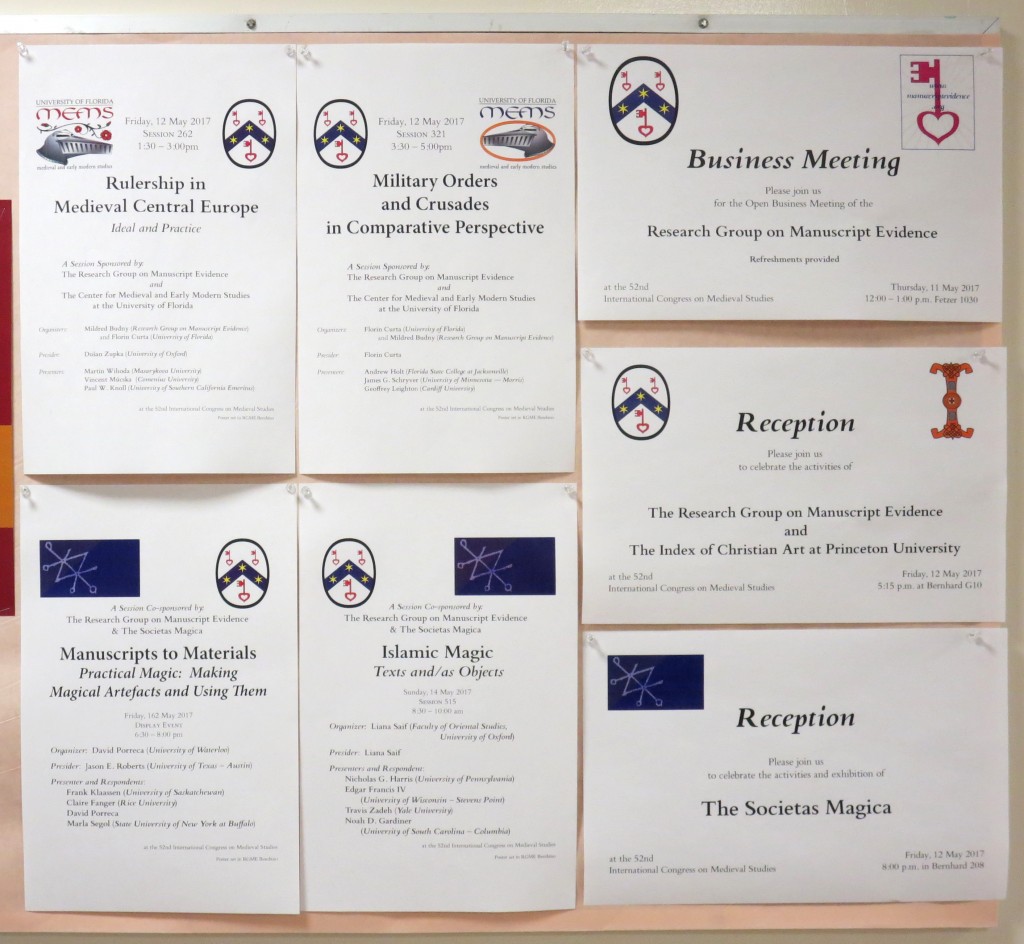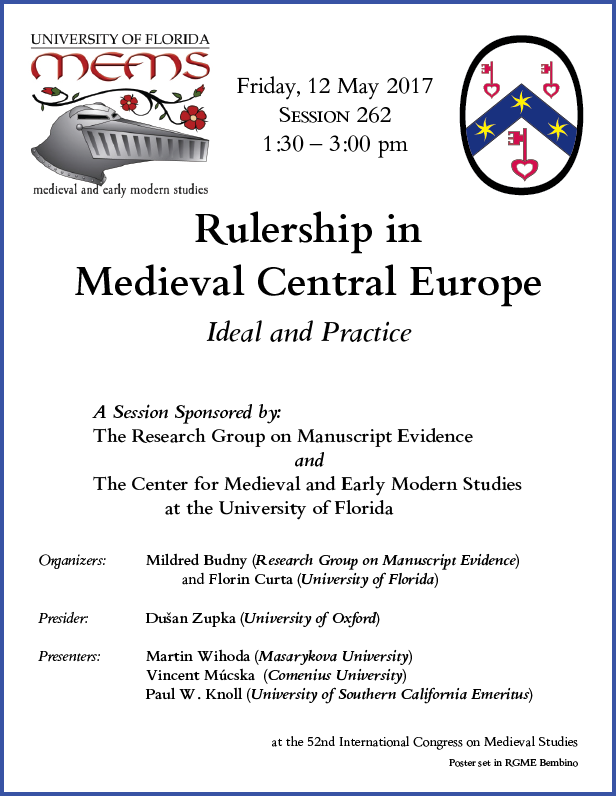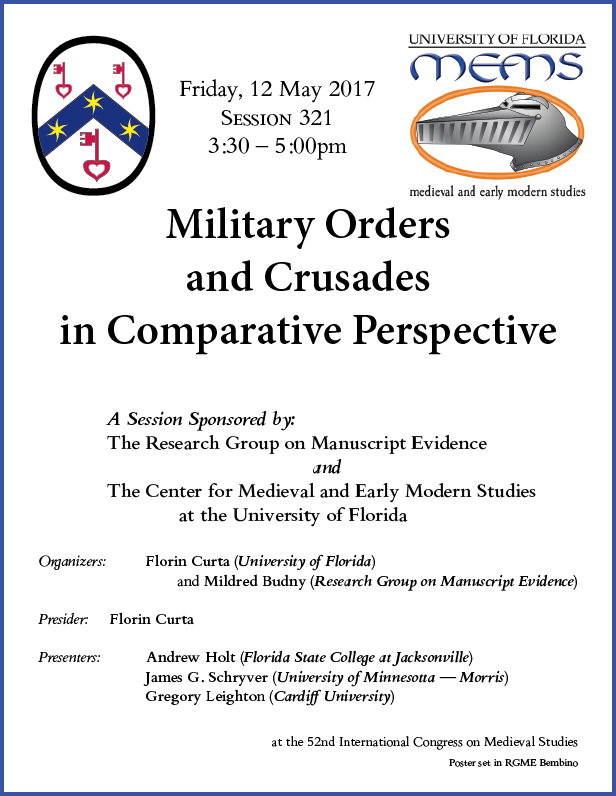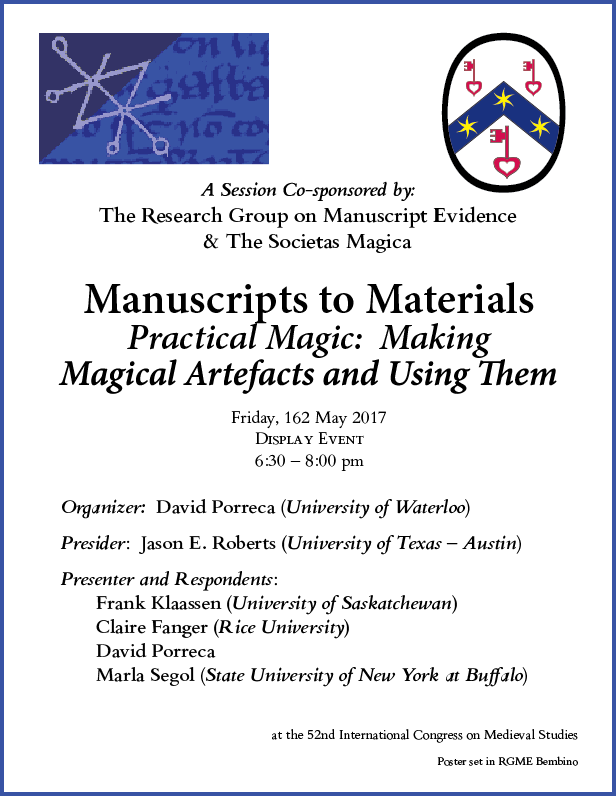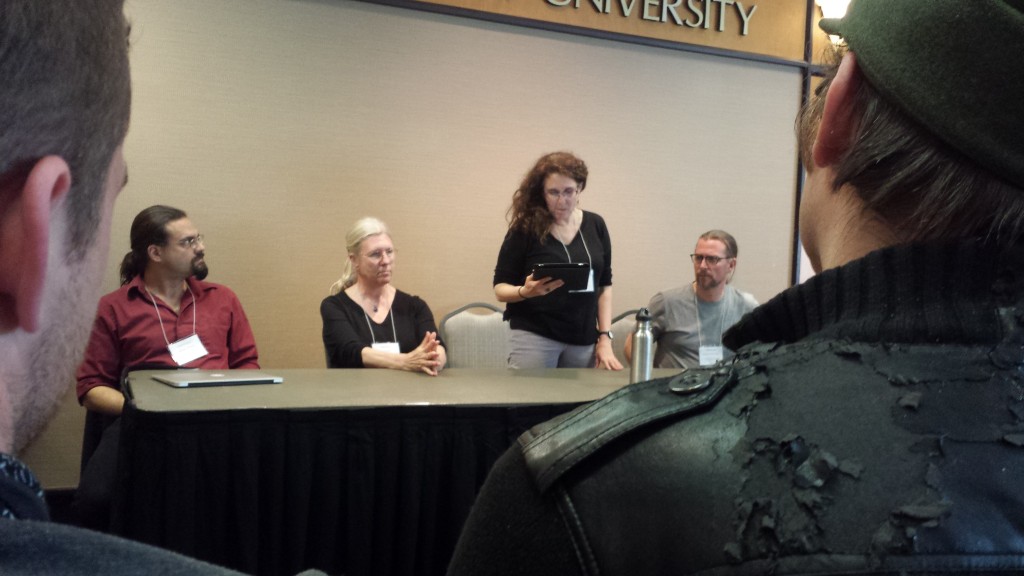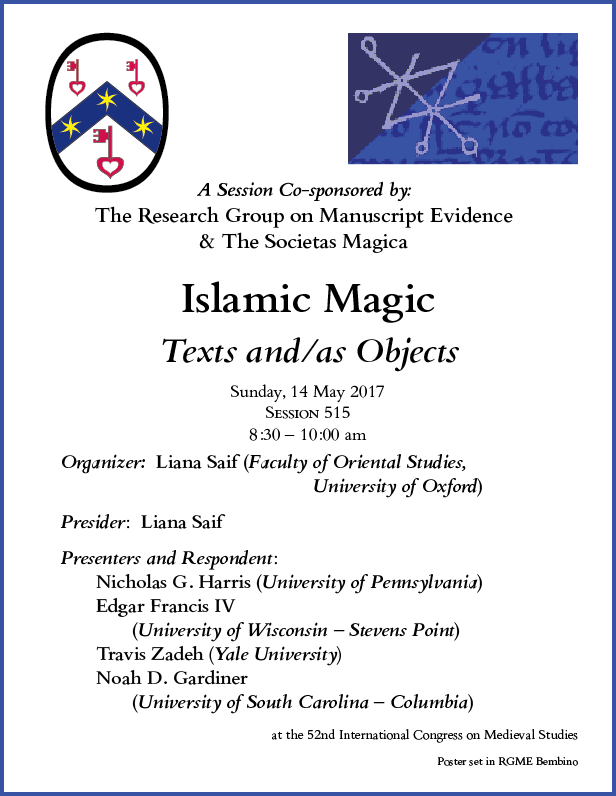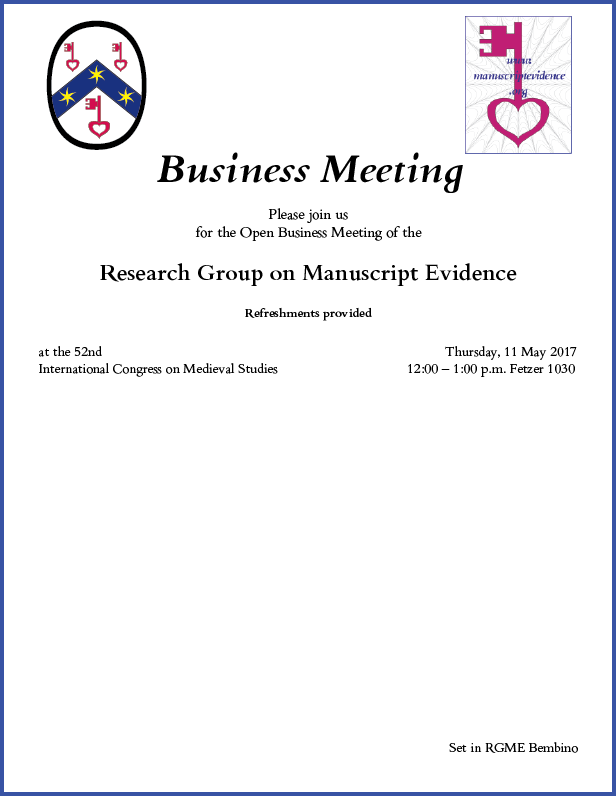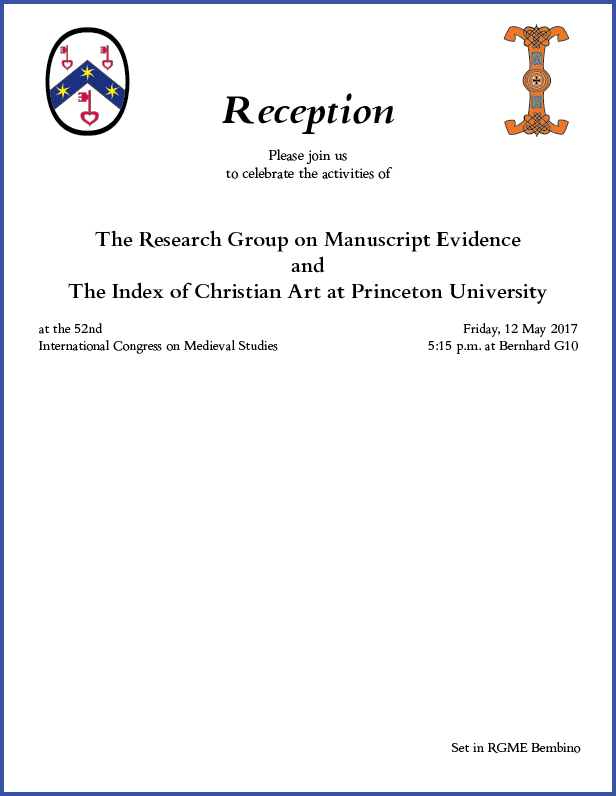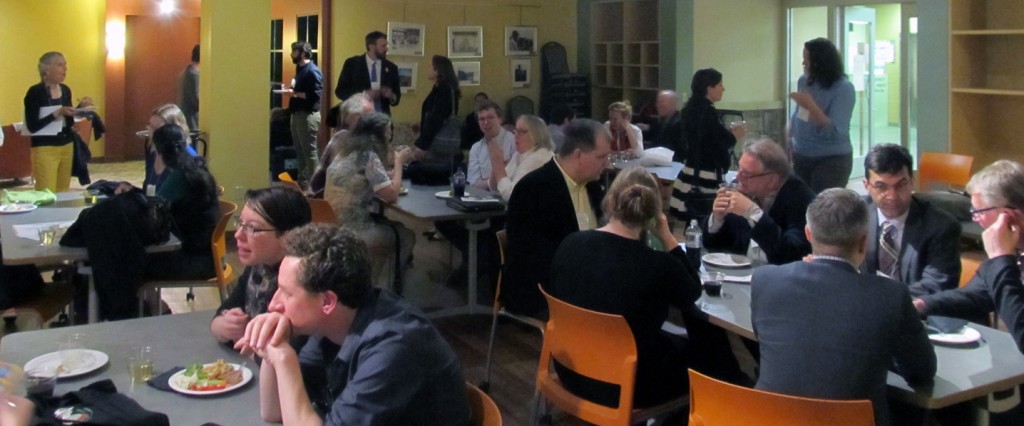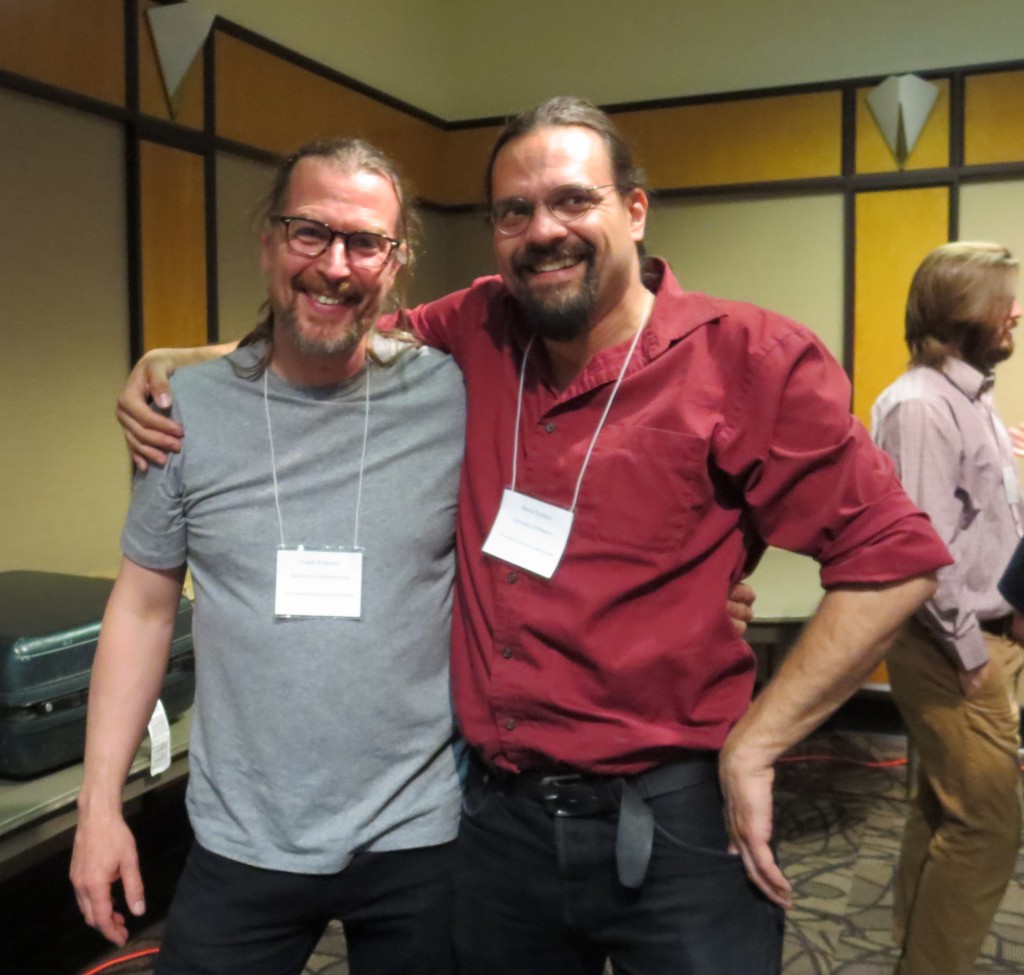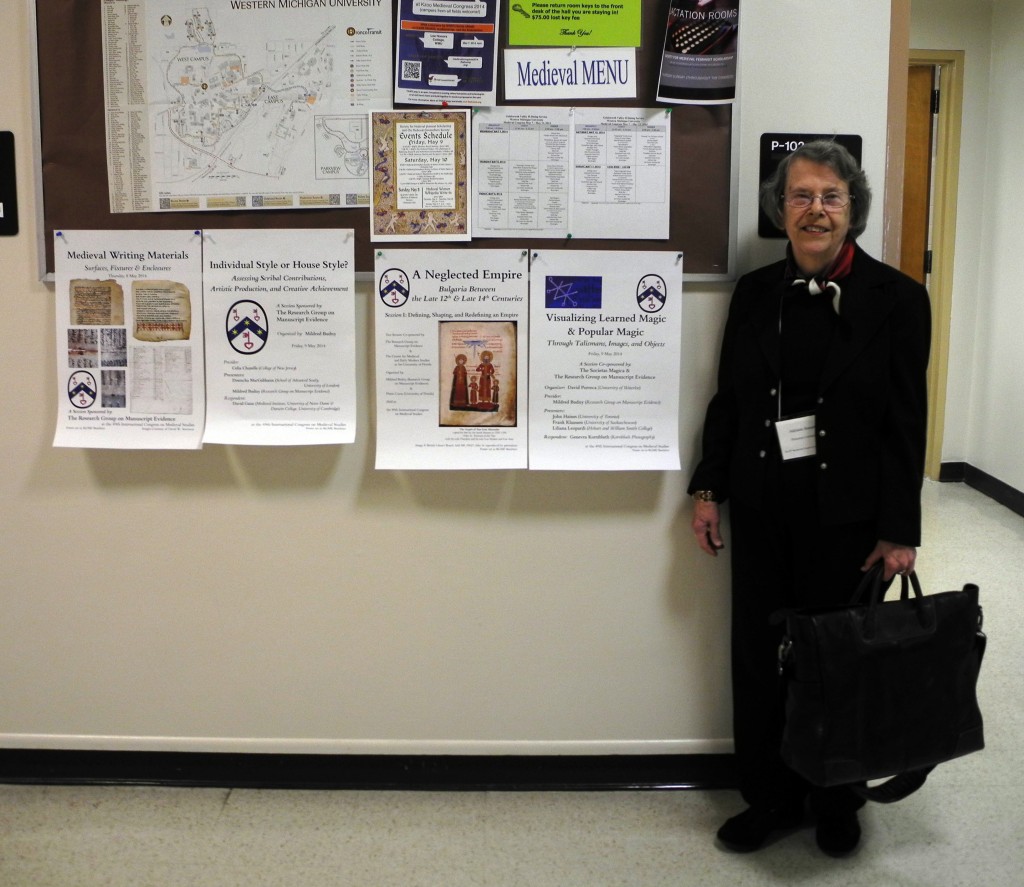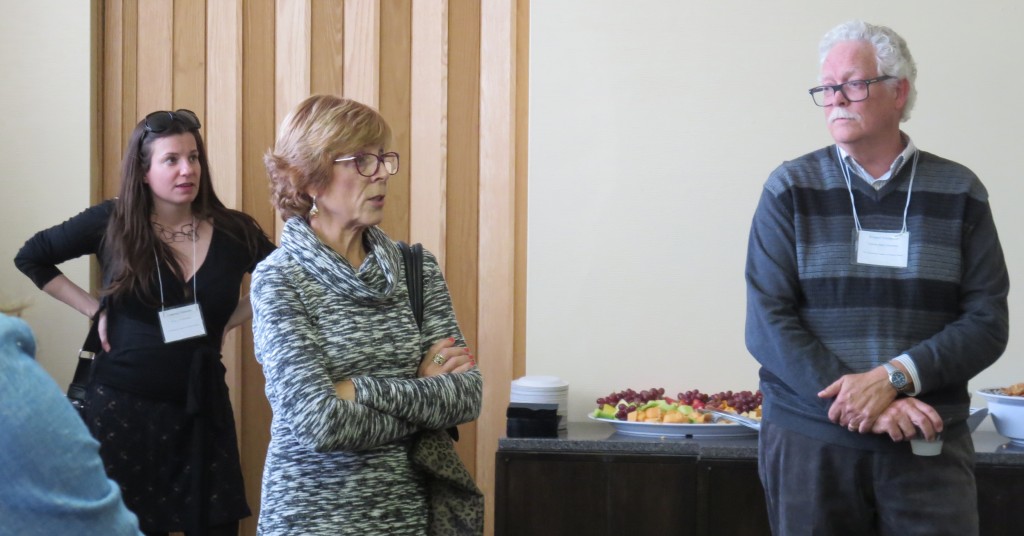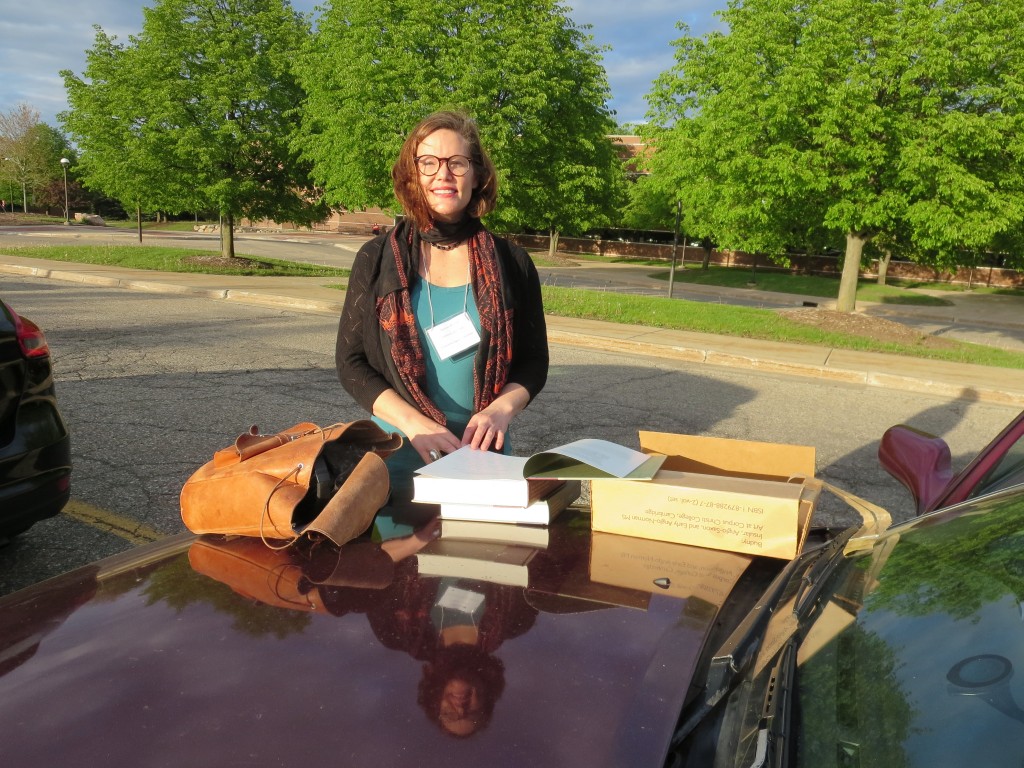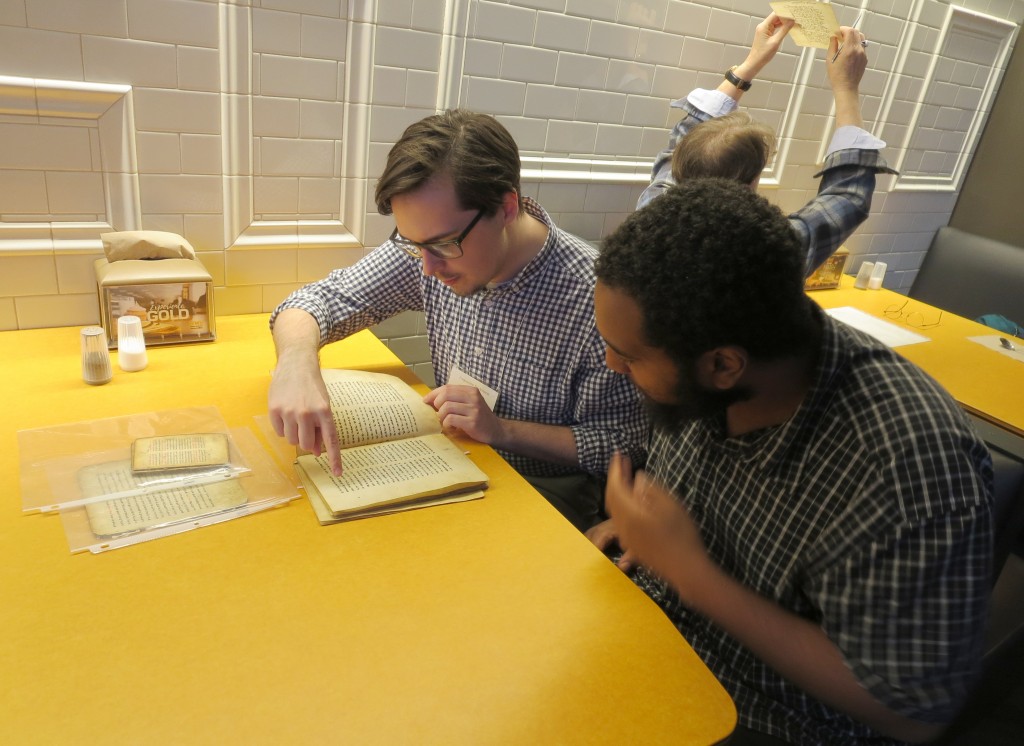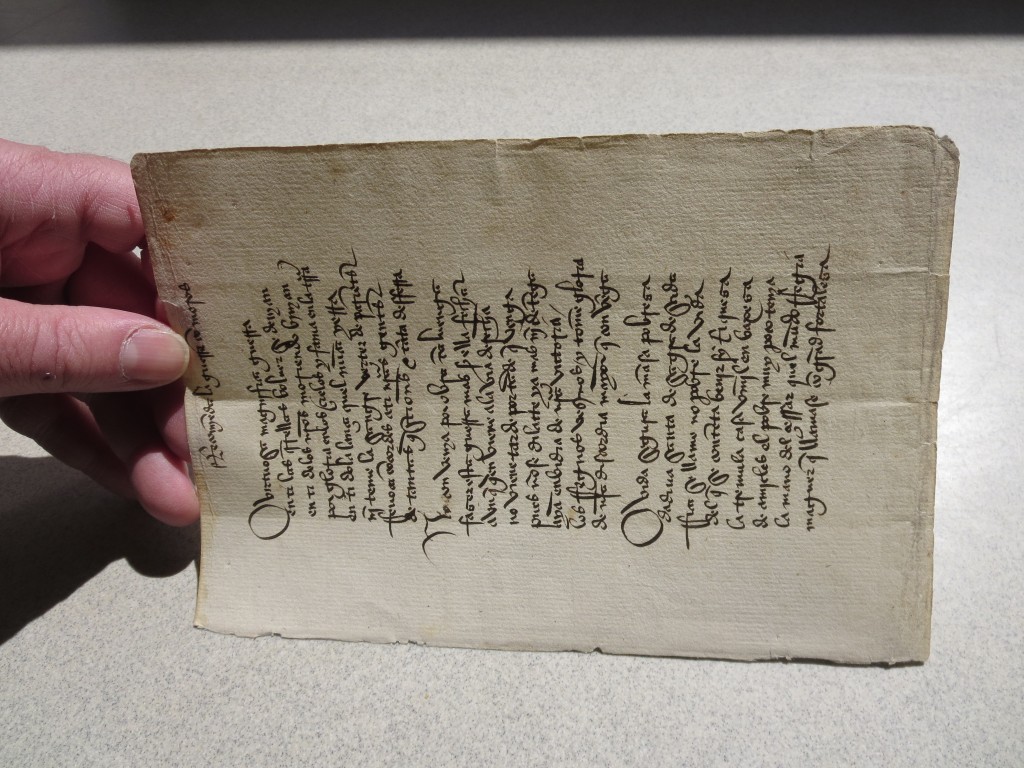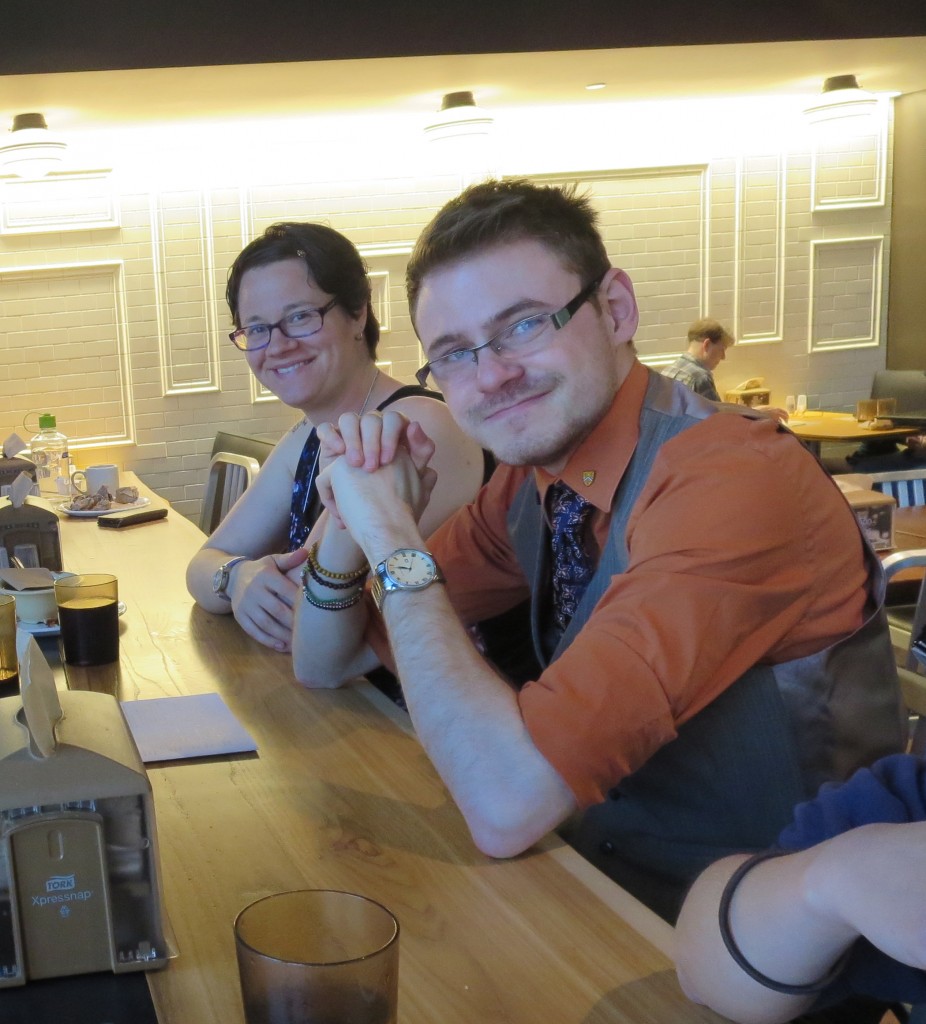2017 Congress Report
May 17, 2017 in Abstracts of Conference Papers, Announcements, Conference, International Congress on Medieval Studies, Kalamazoo
The Research Group on Manuscript Evidence
at the
52nd International Congress on Medieval Studies
Western Michigan University, Kalamazoo, Michigan
11–14 May 2017
We report our Activities Accomplished
The time has happily come to report the successful accomplishment of this year’s Activities of the Research Group on Manuscript Evidence at the 2017 Congress.
Our Activities there mostly corresponded with their plans announced in the complete official Schedule for the 2017 International Congress on Medieval Studies, as well as in our posted (and updated) 2017 Congress Program for our 5 co-sponsored Sessions and other Activities — with some adjustments closer to the time. Some changes were known in time to report to the published Corrigenda (up to 5 May) for the Congress, and on our website. Others emerged at a last minute, and these changes are noted here.
How We Do It
Upon completion of last year’s International Congress on Medieval Studies, we gave both a 2016 Congress Report and a special Behind the Scenes Report (Also Known As “Doctor Who Done It”). Then we turned to preparing for this year’s Congress.
After our proposals for the 2017 sessions were accepted, our 2017 Call for Papers described the scope and aims of the sessions and invited proposals for their papers for consideration. Next, after the official closure of the Call for Papers on 15 September 2016, we selected the programs of the sessions, submitted them to the Congress Committee, and, in due course, announced these 2017 Congress Preparations. Then, as the full Program for the Congress became announced, we posted the Program for our Presence At The Congress, with some updates as they emerged.
As the preparations for the Congress shifted into that next phase, we also, as customary, posted the Abstracts for the Papers, as their authors permit. (Note that our site conveniently lists the published Abstracts not only for the individual years of the Congress, but also in the Indexes both by Author and by Year. Easy Peasy.)
Thus we invite you to discover, even at a distance across time and space, the subjects, aims, and accomplishments of the presenters at the Sessions. That is, even if You Were Not There, You Could Still Be There. Call it, if you wish, the Potential Power of the Word, as Time and Space Traveller.
Now for our 2017 Congress Report. P.S. Our camera disappeared partway through the Congress. Last sighted on the Friday afternoon in Schneider 1030, during our pair of Sessions co-sponsored with the Center for Medieval and Early Modern Studies at the University of Florida. If you happen to have found the camera, we would be glad for the gift of the pictures at the Congress on Days 1 and 2. The rest are secured in copies. Please let us know!
The 2017 Congress
As in recent years, we co-sponsored Sessions with
- the Societas Magica (2 Sessions) and
- the Center for Medieval and Early Modern Studies at the University of Florida (2 Sessions).
This is the 12th year of co-sponsorship with the Societas Magica, and the fourth year with the Center for Medieval and Early Modern Studies. This year, for the first time, we also co-sponsored a Round-Table with a community of 5 other Co-Sponsors (including the Societas Magica), headed by
- AVISTA (The Association Villard de Honnecourt for the Interdisciplinary Study of Technology, Science, and Art).
Also, like the 2016 Congress, we held
- an Open Business Meeting and
- a co-sponsored Reception with the Index of Christian Art at Princeton University.
Glimpses of our co-sponsored Receptions at the Congress appear in the souvenirs of our Celebrations and in the Reports for the individual Congresses (2016, 2015, and 2014 Anniversary).
The Agendas for our Open Business Meetings in both 2015 and 2016 serve as concise Reports for our Activities, Plans, and Desiderata. Continuing to be popular downloads on our site, they speak for the progress of the work and aims of our organization.
Here we list the Sessions in their scheduled order on the Congress Program — also with the adjustments perforce to their Programs, as some intended participants were unable to travel to the Congress and present their papers. Our other Activities remained unaffected by such developments.
As customary in recent years, we prepared a full set of Posters for our Activities at the Congress. Set in RGME Bembino. Details about our copyright multilingual font, which you might download and use for FREE, appear as: Bembino. Pretty, don’t you think?
Sessions
I. Co-Sponsored with AVISTA:
 The Association Villard de Honnecourt
The Association Villard de Honnecourt
for the Interdisciplinary Study of Medieval Technology, Science, and Art
et alia
1. Round-Table co-sponsored with AVISTA and these organizations:
- Medica: The Society for the Study of Healing in the Middle Ages
- DISTAFF: Discussion, Interpretation, and Study of Textile Arts, Fabrics, and Fashion
- EXARC: Archaeological Open Air Museums and Experimental Archaeology (International Organisation of Archaeological Open Air Museums and Experimental Archaeology)
- Societas Magica
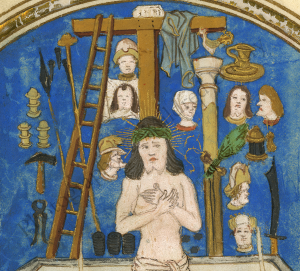
Tools of the Passion of Christ. From a late 15th-century manuscript illustration of the Vision at Mass by Gregory the Great. See our blog on ‘Manuscript Studies’. Photograph © Mildred Budny.
Medieval Tools
Congress Session 41
Thursday 10:00–11:30 a.m.
Sangren 1710
This round-table session aimed to provide an opportunity for short presentations, demonstration, and discussion of medieval tools and technology. They could extend into various realms, including artistic production, agricultural labor, construction, shipbuilding, and household use. The co-sponsorship demonstrates the wide range of materials and methods which come into view.
Organizer:
- Sarah Thompson (Rochester Institute of Technology)
Presider:
- Sean M. Winslow (University of Toronto)
Panelists (speaking in this order, slightly different from the advertised Program):
- Constance H. Berman (University of Iowa)
- Frank Klaassen (University of Saskatchewan)
- Carla Tilghman (Washburn University)
- Linda Ehrsam Voigts (University of Missouri – Kansas City)
- Darrell Markewitz (Wareham Forge)
Frank Klaassen‘s comments focused upon the choices and preparation for the exhibition which formed the subject of our co-sponsored Session on “Manuscripts to Materials” (see below).
As Presider, Sean Winslow added some relevant comments from his own research on Ethiopic scribal materials and practices, with observations about the significance and use of the implements such as the customary stick in inkpots. Sean’s detailed reports of his research have figured, for example, in some of our earlier Congress Sessions, as recorded for the 2014 Congress.
Our own interest in the subject of “Medieval Tools” as a co-sponsored Congress Session flowed naturally, among other things, from our commitment to the occasional series of Sponsored Sessions on “Medieval Writing Materials” (as at the 2016 Congress).
*****
II. Co-Sponsored with
the Center for Medieval and Early Modern Studies
at the University of Florida
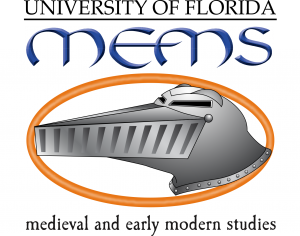 2 Sessions
2 Sessions
Co-organized by
Mildred Budny (Research Group on Manuscript Evidence)
and Florin Curta (University of Florida)
2. Rulership in Medieval Central Europe
(Bohemia, Hungary, and Poland):
Ideal and Practice
Congress Session 262
Friday 1:30 – 3:00 p.m.
Schneider 1360
Much has changed over the last 15 years or so in the study of political ideology, rituals, and symbols. The debate over ritual between Gerd Althoff and Philippe Buc has not taken into consideration the large body of literary evidence pertaining to court rituals and ideal representations of power in East Central Europe. On the other hand, this debate has only recently percolated to centers of historical research in that region. The results of those combined changes have not yet received closer scholarly scrutiny.
This session was meant to provide an overview of the most recent research on ideal rulership in theory and practice, with a particular emphasis on East Central Europe. Was the region different in that respect from Western Europe? Are there any specific features of the ideal representation of rulership in Bohemia, Poland, and Hungary? What are the most salient features of the ritual practice of power in the region?
Organizers:
- Mildred Budny (Research Group on Manuscript Evidence) and
Florin Curta (University of Florida)
Presider:
- Dušan Zupka (University of Oxford)
Presenters:
- Martin Wihoda (Masaryk University, Brno, Czech Republic)
“Rulership in Early Medieval Bohemia: Between Ideals and Everyday Reality”
Abstract of Paper - [Vincent Múcska (Comenius University in Bratislava, Slovakia)
“Theory and Practice of Legitimizing Royal Power in Early Medieval Hungary: The Árpád Dynasty”]
Abstract of Paper - [Zbigniew Dalewski
(Tadeusz Manteffel Institute of History, Polish Academy of Sciences, Warsaw, Poland)
“The Plast Rulership: The Process of Building Dynastic Power”]
Abstract of Paper - Paul W. Knoll (Department of History, Emeritus, University of Southern California)
“Royal Exercise of Political, Cultural, and Legal Leadership in Fourteenth-Century East Central Europe”
Abstract of Paper
[Update: Shortly before the Congress, we learned that both Vincent Múcska and Zbigniew Dalewski could not, after all, attend the Congress to present their papers. One of these changes to the Program was reported in time to appear in the Corrigenda for the Congress Program, distributed at the Congress, and available on its website.
Here, on our website, the Abstracts for those two Papers may remain in place, as is our custom, as a declaration of their authors’ intentions, as we respect the willingness to contribute to the explorations of the session and its subject of consideration.]
3. Military Orders and Crusades in Comparative Perspective
(The Levant, Spain, and the Baltic Region)
Session 321
Friday 3:30 – 5:00 p.m.
Schneider 1360
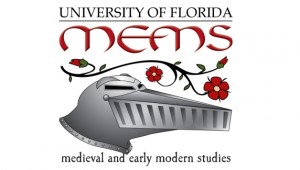 Renewed interest in the history of the military orders has resulted in a rapid proliferation of studies dedicated to the Templars, Hospitallers, and the Teutonic Knights, but no synthesis dedicated to minor orders, such as Calatrava or the Brothers of the Sword. Meanwhile, a particular sub-field of medieval archaeology dedicated initially to crusader castles in the Levant has begun to draw attention to similar phenomena in the Baltic region, inviting comparison. Aleksander Pluskowski‘s Archaeology of the Prussian Crusade (2013) is the first book to compare systematically the Holy Land and the Baltic region. Missing, however, is a comparison with the Iberian Peninsula.
Renewed interest in the history of the military orders has resulted in a rapid proliferation of studies dedicated to the Templars, Hospitallers, and the Teutonic Knights, but no synthesis dedicated to minor orders, such as Calatrava or the Brothers of the Sword. Meanwhile, a particular sub-field of medieval archaeology dedicated initially to crusader castles in the Levant has begun to draw attention to similar phenomena in the Baltic region, inviting comparison. Aleksander Pluskowski‘s Archaeology of the Prussian Crusade (2013) is the first book to compare systematically the Holy Land and the Baltic region. Missing, however, is a comparison with the Iberian Peninsula.
The session was meant to bridge that gap and to invite more discussion around the regional experiences of one and the same order (e.g., the Teutonic Knights in the Levant, Transylvania, and Prussia) or between different orders in different regions (e.g., the Order of Calatrava and the Brothers of the Sword in Spain and in Livonia respectively). The material culture and the multiple studies based on the archaeology of the landscape (that go far beyond the analysis of single castle sites) offer a very rich ground for comparative work, but most archaeologists working in the Prussian lands do not read the literature on castles in Spain, and vice-versa.
Thus, the session was meant to illustrate what can be done to revise the historical record through the already exceptional amount of information available from archaeological excavations. Considering comparative work on the military orders in crusade, both within specific orders and among them, and both within specific regions and across them, may bring to light unexpectedly shared issues, questions, and potential for enriched understanding.
Organizers:
- Mildred Budny (Research Group on Manuscript Evidence) and
Florin Curta (University of Florida)
Presider:
- Florin Curta (University of Florida)
Presenters:
- Andrew Holt (Florida State College at Jacksonville)
“The Templars and the Confraternity of Belchite: A Comparison of Origins”
Abstract of Paper - James G. Schryver (University of Minnesota – Morris)
“An Archaeology of the Military Orders in the Holy Land?”
Abstract of Paper - Gregory Leighton (Cardiff University)
“Intraverunt terram horroris et vaste solitudinis:
The Teutonic Order and Landscape Sacralization in the Crusade to Prussia”
Abstract of Paper
*****
III. Co-Sponsored with the Societas Magica
4. Manuscripts to Materials
Friday 12 May
Bernard 208
6:30 – 7:00 p.m.
To practice learned magic in the pre-modern world one could not simply go to a store or take a course. It was certainly far more complicated than slavishly following a set of techniques. A would-be practitioner had to acquire manuscripts, interpret them, then acquire the prescribed ingredients and build the necessary equipment based on the written instructions. Once this was accomplished and the processes completed, the results were at once highly evocative and ambiguous, requiring interpretation. Thus at two stages highly creative and imaginative processes had to be called upon. This session + display exhibition (focused on hands-on re-creations of ancient and medieval divination techniques) examined the intersection between the creative and the learned in pre-modern magical practice.
Organizer:
- David Porreca (Department of Classical Studies, University of Waterloo)
Presider:
- Jason Roberts (University of Texas – Austin)
Presenter:
- Frank Klaassens (College of Arts and Science, University of Saskatchewan)
Respondents:
- Claire Fanger (Rice University)
- David Porreca
- Marla Segol (State University of New York at Buffalo)
The panel speaks, to a packed audience. Intriguing exhibition, too.
5. Islamic Magic: Texts and/as Objects
Session 515
Sunday 14 May
8:30 –10:00 a.m.
Schneider 1275
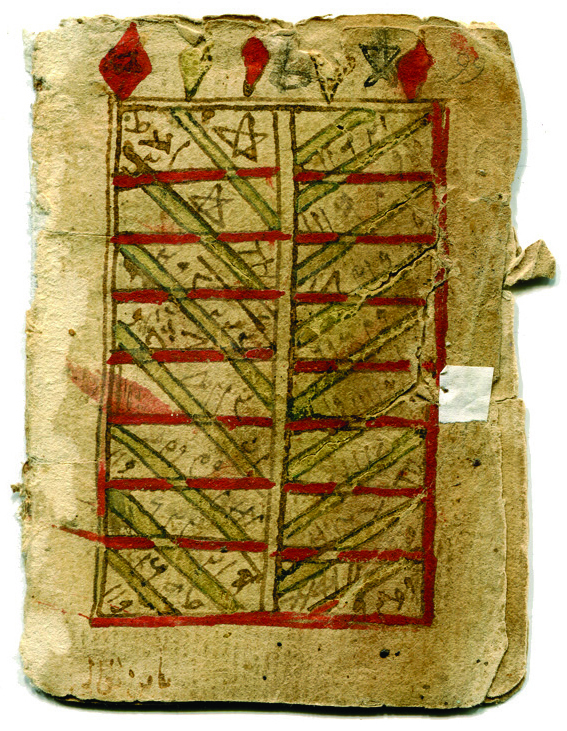
First recto of a fragmentary bifolium in Arabic on paper, from a small manuscript, circa 16th century CE. Text probably occult. See our Gallery of ‘Scripts on Parade’.
Despite the recent burgeoning of the field of Islamic occultism, the vast majority of manuscripts dealing with astrology, various forms of magic and divination, and ecstatic practices remain untapped. Such objects represent a primary basis for both the intellectual and material-cultural history of Islamic civilization, and show the interdependence of these categories; they further require the recovery of discourses heretofore elided in modern scholarship on Islamic history. This session, which introduces a number of newly discovered Arabic manuscripts, highlights the special status of these manuscripts as texts and evocative objects, with particular attention to their visual elements.
Organizer
- Liana Saif (Faculty of Oriental Studies, University of Oxford)
Presider:
- David Porreca (University of Waterloo)
Presenters:
- Nicholas G. Harris (University of Pennsylvania)
“Books as Robots: Authorship and Agency in Islamicate Alchemical Manuscripts” - Edgar Francis, IV (University of Wisconsin – Stevens Point)
“Approaching Shams al-ma’arif al-kubrá through Early Manuscripts: MSS Arabe 2650–51 in the Bibliothèque nationale de France”
Abstract of Paper - Travis Zadeh (Yale University)
“Legible Signs? Cyphers, Talismans, and the Theologies of Early Islamic Sacred Writing”
Respondent:
- Noah G. Gardiner (University of South Carolina – Columbia)
*****
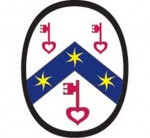 Research Group on Manuscript Evidence
Research Group on Manuscript Evidence
2017 Open Business Meeting
Thursday 11 May
12:00 – 1:00
Fetzer 1030
Since 2015, we hold an Open Business Meeting at the Congress. Their downloadable Agendas serve as concise Reports for our Activities, Pans, and Desiderata. The Agendas remain available for consultation and inspiration. The Agendas for our Open Business Meetings in both 2015 and 2016 are now joined by the 2017 Agenda.
Our page on Business Meetings gives a fuller account of the Meeting.
*****
 Reception with hosted bar
Reception with hosted bar
Co-sponsored with the Index of Christian Art at Princeton University
Friday 12 May
5:15 – 7:30 p.m.
Bernhard G10
*****
Other Activities of our Co-Sponsors at the Congress
Other activities of our co-sponsors at the Congress include these:
I. Societas Magica
1. Session 131
Sex Magic: Past and Present, Imagined and Real
Thursday 3:30 – 5:00 p.m.
Presider: Mildred Budny
Liana Saif was unfortunately unable to travel to the Congress to present her Response to this session. The 2 Presenters delivering their papers happen to “belong” or “pertain” to the Research Group on Manuscript [and Other] Evidence as our Invited Associates (see News & Views and Officers, Associates & Volunteers”). It was a great session, Puns Included.
2. Reception with hosted bar
This Reception flowed directly from the Exhibition and our co-sponsored Display Session. Great Stuff.
The creators of the Exhibition, Frank Klaassens and David Porreca (our Associates), happily celebrated the display, the session, and the reception. Nice!
Friday 12 May
Bernhard 208
9:00 p.m.
3. Business Meeting
Saturday 13 May
11:45 a.m.
Fetzer 1055
II. CMERS at the University of Florida
1–2. Sessions 23 and 70
Archaeology of Medieval Europe, I and II
- History and Politics in Medieval Archaeology
Thursday 11 May
10:00 – 11:30 a.m.
Schneider 1335 - Bioarchaeological Research on Eastern Europe
Thursday 11 May
1:00 – 3:00 p.m.
Schneider 1335
III. AVISTA
Business Meeting
Saturday 13 May
12:00
Schneider 1125
IV. Index of Christian Art at Princeton University
1–2. Sessions 280 and 325 In Honor of Adelaide Bennett Hagens, I and II
- Text–Image Dynamics in Medieval Manuscripts
Friday 12 May
1:30 – 3:00 p.m.
Sangren 1750 - Signs of Patronage in Medieval Manuscripts
Friday 12 May
3:30 – 5:00
Sangren 1750
The honoree is our colleague, friend, and Trustee. We celebrate her accomplishments with her Page: Adelaide Bennett Hagens.
*****
Also, another pair of sessions at the Congress celebrated another of our Trustees.
- “In Honor of Richard K. Emmerson: Interdisciplinary Approaches to Medieval Literature, Drama, and Art, I and II”
(Sessions 86 and 133)
*****
Extras
Oh yes, and there were some Book Signings. Perhaps in unexpected places, impromptu, but beautifully illuminated, don’t you think?
Wouldn’t you like your very own copy of this unusual Illustrated Catalogue? Information here.
*****
Plus, Some Manuscript Sightings
Extras, Continued!
With generous, dedicated, and spirited arrangements, it was possible to arrange several viewings of original medieval manuscripts, manuscript fragments, documents, seals, and seal matrices, so that scholars, teachers, and students could gather, here and there at the Congress, to examine the original materials and evidence directly.
More about those encounters in a “Behind the Scenes” Report for the 2017 Congress, but you might like a sneak preview. Photographs by Mildred Budny, happy to have made the introductions between manuscript fragments and the right scholars.
P.S. We prepare expert reports about those “Manuscript Sightings”. Please look for advances with our Galleries and our blog on Manuscript Studies, replete with Contents List.
*****
In sum, it was a great Congress with our Activities, conversations, and friendships. For example, at the Sunday Lunch, just as we all were preparing to disperse for our journeys, short and long, we could sit together and celebrate the meeting of friends. A Picture Worth a Thousand Words, Perhaps:
Let’s see what we might prepare for next year. Your observations are welcome. For example, might you have photographs from the 2017 Congress that you would like to share with us? Do you have thoughts about Activities for the 2018 Congress, or other RGME Events?
*****
Please Contact Us with your questions and suggestions about this Report and about future Activities.
For our nonprofit educational mission, which has tax-exempt status, donations in funds and in kind (expertise, materials, time) are welcome.
*****
—


